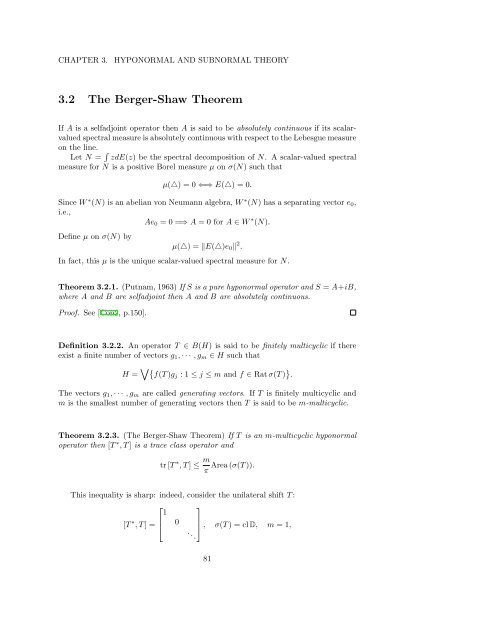Woo Young Lee Lecture Notes on Operator Theory
Woo Young Lee Lecture Notes on Operator Theory
Woo Young Lee Lecture Notes on Operator Theory
You also want an ePaper? Increase the reach of your titles
YUMPU automatically turns print PDFs into web optimized ePapers that Google loves.
CHAPTER 3.<br />
HYPONORMAL AND SUBNORMAL THEORY<br />
3.2 The Berger-Shaw Theorem<br />
If A is a selfadjoint operator then A is said to be absolutely c<strong>on</strong>tinuous if its scalarvalued<br />
spectral measure is absolutely c<strong>on</strong>tinuous with respect to the Lebesgue measure<br />
<strong>on</strong> the line.<br />
Let N = ∫ zdE(z) be the spectral decompositi<strong>on</strong> of N. A scalar-valued spectral<br />
measure for N is a positive Borel measure µ <strong>on</strong> σ(N) such that<br />
µ(△) = 0 ⇐⇒ E(△) = 0.<br />
Since W ∗ (N) is an abelian v<strong>on</strong> Neumann algebra, W ∗ (N) has a separating vector e 0 ,<br />
i.e.,<br />
Ae 0 = 0 =⇒ A = 0 for A ∈ W ∗ (N).<br />
Define µ <strong>on</strong> σ(N) by<br />
µ(△) = ∥E(△)e 0 ∥ 2 .<br />
In fact, this µ is the unique scalar-valued spectral measure for N.<br />
Theorem 3.2.1. (Putnam, 1963) If S is a pure hyp<strong>on</strong>ormal operator and S = A+iB,<br />
where A and B are selfadjoint then A and B are absolutely c<strong>on</strong>tinuous.<br />
Proof. See [C<strong>on</strong>2, p.150].<br />
Definiti<strong>on</strong> 3.2.2. An operator T ∈ B(H) is said to be finitely multicyclic if there<br />
exist a finite number of vectors g 1 , · · · , g m ∈ H such that<br />
H = ∨ {<br />
f(T )gj : 1 ≤ j ≤ m and f ∈ Rat σ(T ) } .<br />
The vectors g 1 , · · · , g m are called generating vectors. If T is finitely multicyclic and<br />
m is the smallest number of generating vectors then T is said to be m-multicyclic.<br />
Theorem 3.2.3. (The Berger-Shaw Theorem) If T is an m-multicyclic hyp<strong>on</strong>ormal<br />
operator then [T ∗ , T ] is a trace class operator and<br />
tr [T ∗ , T ] ≤ m Area (σ(T )).<br />
π<br />
This inequality is sharp: indeed, c<strong>on</strong>sider the unilateral shift T :<br />
⎡ ⎤<br />
1<br />
[T ∗ ⎢<br />
, T ] = ⎣<br />
0 ⎥<br />
⎦ , σ(T ) = cl D, m = 1,<br />
. ..<br />
81













